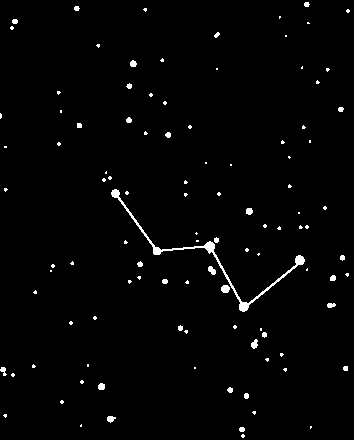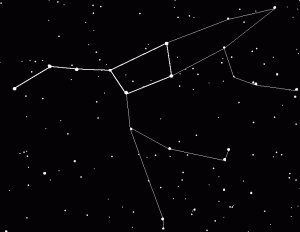Posts Tagged ‘constellations’
Comet Lovejoy
If you are currently lucky with the weather (we are not in Plymouth!), you should be able to see Comet Lovejoy (Comet C/2014 Q2 Lovejoy) in the night sky now. Ideally, it is best to go to a dark area, such as a moor or rural location, as it will be much easier to see it, although you will probably be able to make it out with the naked eye in a more built up area. The very best way to view it would be to go to a really dark place and have a look at it through some binoculars. It will appear like a glowing green blue ball, due to the fact it is made of ice.
The comet was only discovered last year by an Australian astronomer called Terry Lovejoy, but it has been found to have been orbiting the Sun and is about 44 million miles away from the Earth (as of now). So there is no chance that it will hit us! 😉 The last time it came through our part of the Solar System was 11,500 years ago and it won’t be back for another 8,000 years. We will all be travelling around in space by then I think! It appeared closest to Earth on January 7th, but is still going to be a really good view for at least another 10 days, until it will gradually get fainter and fainter as it moves further away from us.
To find Comet Lovejoy in the Sky, you will need to look towards the South of the Constellation Taurus and to the West of the upper half of the Constellation Orion. As the days go on, it will obviously travel onwards and eventually through the edge of Taurus and near to the Pleiades. It should be pretty straight forward to spot if you know your basic Constellations.
This is a great Comet to view and I am crossing my fingers that our skies clear enough for me to have a good look at it! 😉
The Geminids 2014
Over the weekend was the peak of the annual Geminid Meteor Shower. This year, it was actually clear skies over our house meaning the sky was perfectly clear. In fact, it was the best clear sky that we have had for a very long time! There was no moon and the stars and constellations were twinkling beautifully in the night sky. Of course, being this time of year, it meant the clear sky made the temperature absolutely freezing! In fact, it was minus 1.2 by 22:30 so we were quite chilly stood outside!
My wife and I went out to look on two occasions in the evening. The first viewing lasted for about 45 minutes, starting at about 19:45 on Saturday. I was out on my own at first but didn’t see any meteors until my wife made an appearance, which was about 20 minutes in to the viewing. I did have a great time using my camera to try and take photos of the constellation Cassiopeia and the Pleiades but unfortunately my lens wasn’t big enough, so all I took was darkness. It took me a few minutes to get my bearings on where the meteors would originate from, but found that it was directly behind our house. This meant we could stand on the back step and be looking in the correct direction. The only problem with this was that there is a big house directly behind ours, which blocks out the sky. This meant that we had to look directly up, which gave me neck ache the next day!
Anyway, the first viewing picked up and we eventually saw about 8 meteors. Some were very small flashes in the Sky, whilst others zoomed along and left a nice long tail behind. It was great, but we eventually got so cold that we had to go in and have a hot chocolate to drink!
We went back outside at about 10pm for about 30 minutes, by which time the rate of meteors passing by must have picked up as we were treated to some really good ones that shot across the sky and had some amazing tails. The origin of the meteors had passed to the side of the house behind us as well, so we had a clearer view of Gemini by then. I have to say that the constellation Orion looked excellent and very bright as well, which was to the south east of Gemini. At one point we must have seen about 3 big meteors in the space of about 15 seconds, and they were all over the sky. It was great! But, as mentioned above, the temperature had reached sub zero levels by now, and we were just too cold, so we called it a night. In this time we saw about 10 really good meteors, which was very pleasing.
The Geminid Meteor Shower of 2014 was probably the best one that we have seen from our house in Plymouth. The moon was down, the sky was dark and the starts shone so brightly. It was an amazing sight, and to see lots of meteors as well topped it of brilliantly! Here’s hoping for more nights like this when future meteor showers are due! 😉
Perseids 2013
Last night I spent about 40 minutes outside meteor spotting. Luckily it was the first night in ages that there was a mostly clear sky, apart from the occasional wispy clouds that passed overhead. It was good timing as last night was the peak of the Perseid Meteor shower of 2013 although you can still see meteors up until the 24th August when the Earth passes out of the meteor hot spot.
It took a while to spot anything but in the end I managed to see 8 meteors, 4 satellites, the International Space Station (ISS – which was a nice surprise!) and a strange looking triangle shaped Plane with weird flashing lights (aliens? 😉 ). The most interesting thing of all was that I also saw a bright flash in the sky and then it gradually faded away. I think it must have been a larger meteor hitting the atmosphere and exploding or something but it seemed to be heading in the wrong direction for the meteor shower, which made it more strange. It would be interesting to know if anyone else saw this last night? It must have been about 23:20 when I saw this. Please leave a comment on this post if you did see that last night as well!
As mentioned above, if you missed the meteor show last night, then you can still see them up until near the end of the month. If you can find the constellations of Cassiopeia and The Plough (Ursa Major), then kind of look between and above them and this is the general area where the meteors shoot across the sky. There were some really good ones and a couple of years ago I saw the best meteor I have ever seen towards the end of August, so it is definitely possible to see them for a few weeks yet!

